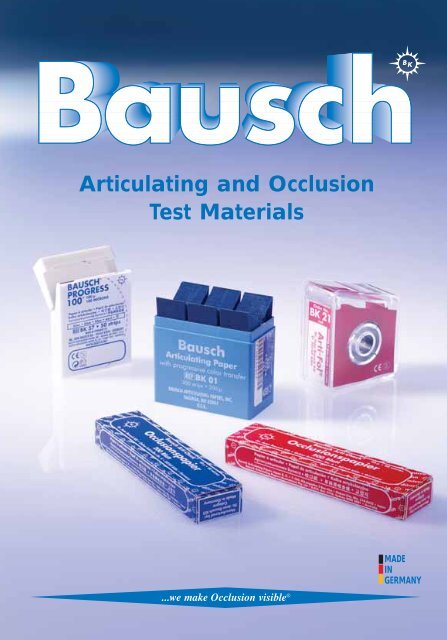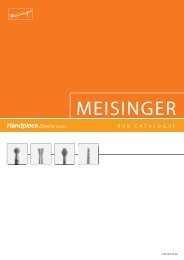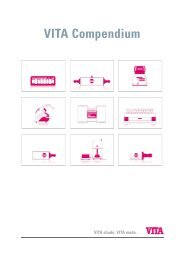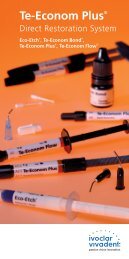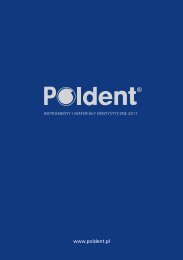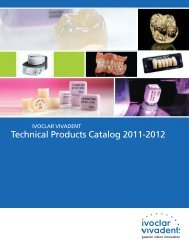Articulating and Occlusion Test Materials - Janouch Dental
Articulating and Occlusion Test Materials - Janouch Dental
Articulating and Occlusion Test Materials - Janouch Dental
- No tags were found...
Create successful ePaper yourself
Turn your PDF publications into a flip-book with our unique Google optimized e-Paper software.
Factory in Rhinel<strong>and</strong>-Palatinate, GermanyBausch U.S.A.Bausch JapanOffice in Cologne, Germany...we make <strong>Occlusion</strong> visible ®
Bausch - Name <strong>and</strong> Concept for<strong>Articulating</strong>-<strong>Test</strong>-<strong>Materials</strong>The correct physiological recovery of the occlusion poses a major challenge for every dentist <strong>and</strong>technician. Even the smallest high spot, measuring just a few microns, can cause dysfunction inpatient’s masticatory system. In restorative dentistry, occlusal proportions are constantly changing.It is therefore essential, for the benefit of the patient, to underst<strong>and</strong> <strong>and</strong> monitor the function of teethin static <strong>and</strong> dynamic occlusion.Since 1953, Dr. Jean Bausch KG has specialized in manufacturing special articulating – occlusiontest materials designed to representocclusal proportions on the masticatorysurfaces as true to nature as possible. Thedentists Dr. Jean Bausch <strong>and</strong> Dr. HansBausch, founders of the company,recognized the need to use pressuresensitivearticulating paper in order topresent all the different masticatory forcesusing various colors. The principle ofprogressive color transfer remains anDr. Jean Bausch*1890 †1966Dr. Hans Bausch*1928 †1998important method for the accurate detection of high spots.As one of the leading manufacturers, continually developing innovations, Dr. Jean Bausch KG offersan extensive range of different articulating papers <strong>and</strong> articulating test-films in different shapes, sizes<strong>and</strong> colors. Being able to achieve markings on difficult surfaces, such as highly polished alloys <strong>and</strong>ceramics is our highest priority. Bausch products are used in over 120 countries. All products aremanufactured in strict compliance with the European Medical Products Decree <strong>and</strong> are constantlymonitored by our Quality Assurance Department. The raw materials used are physiologically safe.This brochure is mainly produced for the practical user of our products in order to find the productof his or her needs. Functional occlusion is important for the overall health of the patient. Theinterdisciplinary verification of symptoms <strong>and</strong> treatment is an integral part of daily practice.Therefore, checking the occlusion during treatment is strongly encouraged....we make <strong>Occlusion</strong> visible ® 3
<strong>Occlusion</strong> <strong>and</strong> Occlusal Interferences<strong>Occlusion</strong>Static <strong>Occlusion</strong>Dynamic <strong>Occlusion</strong>Contacts between upper <strong>and</strong> lower teeth in static <strong>and</strong> dynamicContacts between teeth without movement in intercuspidationContacts between teeth occuring under movement of the m<strong>and</strong>ibleCentric <strong>Occlusion</strong> static occlusion in centric related condyle position (Fig. 1)Maximal <strong>Occlusion</strong>(= maximal Intercuspation) = static occlusion withmaximum contacts between teeth (Fig. 2)Habitual <strong>Occlusion</strong> the consistent relationship of teeth in maximum intercuspation (Fig. 8)Occlusale Interference /high spotpremature contact between a tooth or group of teeth in static ordyamic occlusionDeflective OcclusalContacttooth contact that diverts the m<strong>and</strong>ible from a normal path of closure tocentric jaw relation, moving the condyle to an eccentric position inhabitual occlusion (Fig. 6)Traumatogenic<strong>Occlusion</strong>CR-PositionPremature contact in static <strong>and</strong> dynamic occlusion, which resultsin distruction of the tooth <strong>and</strong> / or it’s paradontiumSource of the nomenclature: www.dgfdt.deCR: Centric RelationCO: Centric <strong>Occlusion</strong>Maximum Intercuspation(Palatal View)Fig. 1 Fig. 2Centric Relation: The position of the m<strong>and</strong>ible tothe maxilla, with the intra-articular disc inplace, when the head of the condyle is againstthe most superior part of the distal facingincline of the glenoid fossa. This can beparaphrased as uppermost <strong>and</strong> foremost.Maximal intercuspal position: Maximumcontacts with the cusp-to-fossa relationship ofthe maxillary teeth to each other.4...we make <strong>Occlusion</strong> visible ®
CO = CRFig. 3 Fig. 4Condyles in CR-PositionOcclusal contacts in Centric<strong>Occlusion</strong>Fig. 5 Fig. 6Condyles in CR-PositionOcclusal InterferenceCO ≠ CRFig. 7 Fig. 8New occlusal contacts in maximum Eccentric position of the condylesintercuspationin habitual position...we make <strong>Occlusion</strong> visible ® 5
CMD SyndromCranio-M<strong>and</strong>ible DysfunctionHeadacheHypersensitivityto lightEar ache •Tinnitus •Sensitivity to noise•TMJ ProblemsBruxismNeck painDifficulties in swallowingShoulder pain6...we make <strong>Occlusion</strong> visible ®
<strong>Occlusion</strong> <strong>and</strong> the potential effects ofocclusal interferences on patientsEvery restoration, extraction, prosthetic device <strong>and</strong> orthodontic treatment changes the occlusion instatic <strong>and</strong> dynamic. Smallest occlusal interferences of just a few microns, are disruptive for thepropriorreceptors of the stomatological system. This can cause bruxism (clenching or grinding),which can result in functional disorder of the cranio m<strong>and</strong>ible system. Overstraining teeth,periodontium, muscles <strong>and</strong> joints are the effect.Functional features of the periodontiumForce on tooth contactPremature contactAlveolar boneCementum“Proprioreceptors”quickly adaptingreceptors: react tocontact (Anterior)“Pressoreceptors”slowly daptingreceptors: react topressure (Posterior)“Collagene fibres”Act as a buffer,suspension.(max. tooth movementapprox. 20µ)It is important not only to detect, but also to avoid further functional disorder in the cranio m<strong>and</strong>iblesystem. Smallest interferences in habitual occlusion can cause serious disturbances for the patient.Acute functional disorder such as clenching <strong>and</strong> grinding can become chronic in the long term.Patients with new fillings, crowns <strong>and</strong> bridges or even after orthodontic treatment, who complainof typical symptoms (CMD-Syndrome), should undergo a specific examination of their occlusion.Premature contacts are often uncomfortable, as the propriorreceptors react sensibly underpressure. The patient will try to compensate for the occlusal interference by adapting to a newhabitual position, with consequences for the attached tissue structures....we make <strong>Occlusion</strong> visible ® 7
The principle ofprogessive color transferLow pressureChewing force invertical direction<strong>Articulating</strong> paperwith color-saturatedmicroporesHigh pressureChewing force invertical direction<strong>Articulating</strong> paperwith color-saturatedmicroporesOcclusalcontactA light occlusal markis not necessarily anocclusal contactA dark occlusal markis an occlusal contact orpremature contact (high spot)Occlusal contact/premature contact= light surfaceGreatest mastecatory pressure!(In the case of a normal contact,this area should be dot like, with thesmallest possble diameter)High pressure=Premature contactLow pressure=Normal contactSurrounding area =Dark ring-shaped bulgeNot part of the contact!8...we make <strong>Occlusion</strong> visible ®
Accurate detection of High SpotsTo visually check the occlusion, we offer an extensiveassortment. There are different papers, silks <strong>and</strong> foils, tofulfill the multiple requirements needed to preciselyanalyze tooth contact relations in static <strong>and</strong> dynamicocclusion.To visualize occlusal contacts accurately, we recommendusing a combination of various testing materials.Bausch <strong>Articulating</strong> Paper with progressive color transferhas proven to be the best in visualizing static occlusion.The spongelike structure of the soft micro fleece paper,stores the color, which is released under pressure. Onheavy contacts (=greatest masticatory pressure), morecolor is squeezed out, therefore producing dark marks; on light contacts (=slight masticatorypressure) accordingly less color, therefore light marks. To visualize contacts on saliva moistenedsurfaces, the contact color is optimized by adding a Transculase ® bonding agent. The progressivepapers therefore mark extremely well on wet, polished metal or highly glazed porcelain surfaces.Due to this specific pressure sensitive articulating paper, an exact relief of pressure distribution inhabitual occlusion can be achieved.For the visual interpretation of occlusal relations, a combination of different occlusion testingmaterials, have proven best in every day practice.Low pressureHigh pressureSurrounding area =NO occlusal contactActual contact...we make <strong>Occlusion</strong> visible ® 9
Checking the occlusion uThe combination of Bausch <strong>Articulating</strong> Paper 200µ or BauschPROGRESS 100 ® with Arti-Fol ® articulating film 8µ or Arti-Fol ® metallic12µ, offers considerable advantages, especially on occlusal surfacessuch as gold or ceramic which are difficult to examine.The first test is made with blue articulating paper, transferring thepigments <strong>and</strong> a thin coat of Transculase ® bonding agent to the occlusalsurface. Contacts are immediately evident.1st Step: <strong>Articulating</strong> PaperExamining the occlusion using Bausch <strong>Articulating</strong> Paper with progressive color transfer 200 µor Bausch PROGRESS 100 ® Articuling Paper with progressive color transfer 100 µor<strong>Articulating</strong>Paper 200µPROGRESS100µDifferences betweenpaper <strong>and</strong> foilProgressive Paper• Marks under pressure• Larger contact marks• Shows differentpressure forces• To check staticocclusion• Marks extremely wellon wet surfaces<strong>Articulating</strong> Foil• Marks on stroke• Contacts are pin points• Marks high spotsprecisely• To check static <strong>and</strong>dynamic occlusionThe blue contacts with the Transculase ® bondingagent, form a contrasting background forprecise occlusal relations.10...we make Oc
using the 2 step methodThe second step is to take a thin film, preferably red, which offershigh intensity <strong>and</strong> an excellent contrast to blue. Due to the fine coatof Transculase ® bonding agent, the color transfer off the film isimproved considerably. This method offers utmost reliability.Now high spots are totally visible.2nd Step: <strong>Articulating</strong> FoilChecking the occlusion using Bausch Arti-Fol ® red 8µ or Arti-Fol ® metallic red 12µorArti-Fol ®Arti-Fol ®8µmetallic 12µThe marks of the articulating foil are morevisible due to the Transculase ® bonding agent ofthe articulating paper.cclusion visible ®11
Bausch <strong>Articulating</strong> Paperswith progressive color transfer - 200 micronsSchematic structure of Bausch <strong>Articulating</strong> Paper withprogressive color transferMicronized color pigment in oil-wax emulsion covered withTransculase ® bonding agentMicro fleece paper with high color storage capacityTransculase ® bonding agent to improvecolor-transfer on wet, highly polished metal orglazed ceramic surfacesMicronized color pigment in oil-wax-emulsion12...we make <strong>Occlusion</strong> visible ®
Bausch <strong>Articulating</strong> Paperswith progressive color transfer - 200 micronsBausch 200µ <strong>Articulating</strong> Paper with progressive color transfer, that highlights overall pressuredistribution by means of different color shades:THE LIGHTER THE BITE, THE LIGHTER THE MARKTHE HARDER THE BITE, THE DARKER THE MARKA dentist can easily obtain accurate pressure distribution within seconds. High spots areimmediately visible.Bausch 200µ <strong>Articulating</strong> Paper with progressive color transfer can highlight any existingmasticatory pressure interference clearly. Thinner test products which are available in thicknessesof up to 8µ (Arti-Fol ® ) should be used after adjusting <strong>and</strong> localizing the problem area.Item: Contents: Color: Order No.:Plastic dispenser 300 strips blue BK 01Refill-Box 300 strips blue BK 1001Plastic dispenser 300 strips red BK 02Refill-Box 300 strips red BK 1002Plastic dispenser horseshoe 50 sheets blue BK 03Plastic dispenser horseshoe 50 sheets red BK 04Box with booklets straight 300 strips blue BK 05...we make <strong>Occlusion</strong> visible ® 13
Bausch PROGRESS 100 ®<strong>Articulating</strong> paper 100 microns with progressive color transferSchematic structure ofBausch PROGRESS 100 ®Micronised color pigment in oil-wax emulsion covered with"Transculase ® " bonding agentFiber reinforcedspecial paper 100 microns14...we make <strong>Occlusion</strong> visible ®
Bausch PROGRESS 100 ®<strong>Articulating</strong> paper 100 microns with progressive color transferThis smooth fiber reinforced paper with high coloring capacity adapts perfectly to the occlusalsurfaces. The occlusal contact points or centric contacts are marked very precisely because of thepaper’s progressive color transfer.This 100 micron paper is impregnated with hydrophilic waxes <strong>and</strong> pharmaceutical oils. Thisunique combination with the bonding agent Transculase ® enhances detection of high spots on hardto locate surfaces, such as highly polished metals or ceramics. Its hydrophilic properties make itadvantageous for use on moist occlusal surfaces - a highly desirable attribute.Item: Contents: Color: Order No.:Plastic dispenser 300 strips blue BK 51Plastic dispenser 300 strips red BK 52Plastic dispenser in horseshoe 50 sheets blue BK 53Plastic dispenser in horseshoe 50 sheets red BK 54Plastic dispenser 50 strips blue BK 57Plastic dispenser 50 strips red BK 58...we make <strong>Occlusion</strong> visible ® 15
Bausch <strong>Articulating</strong> Silkwith progressive color transfer - 80 micronsSchematic structure of Bausch <strong>Articulating</strong> Silkwith progressive color transferMicronised color pigment inwax-oil emulsionFibrils with high colorreservoir capacityBonding agent Transculase ®for improvement of colortransfer on highly polishedsurfaces such asgold or ceramicMicronised color pigmentin wax-oil emulsioncovered withTransculase ® bondingagent.
Bausch <strong>Articulating</strong> Silkwith progressive color transfer - 80 micronsBausch <strong>Articulating</strong> Silk is made from high quality natural silk featuring the same properties asBausch 200µ <strong>Articulating</strong> Papers with progressive color transfer. This silk is highly tear-resistant<strong>and</strong>, because of its low thickness <strong>and</strong> good flexibility, it adapts perfectly to cusps <strong>and</strong> fossae.The marking of silk is extremely precise <strong>and</strong> therefore suitable for more delicate preparations.Natural silk consists of fibrils, a tube-shaped protein structure which, because of its composition,has an extremely high color reservoir capacity. <strong>Articulating</strong> Silk is especially suitable for the useon a laboratory model because one strip can be used up to ten times <strong>and</strong> is thus extremelyeconomical.Item: Contents: Color: Order No.:Roll 80 mm wide 3 m red BK 06Roll 80 mm wide 3 m green BK 876Roll 80 mm wide 3 m blue BK 877Roll 16 mm wide 10 m blue BK 07Roll 16 mm wide 10 m red BK 08
Bausch <strong>Articulating</strong> PapersArti-Check ®micro-thin - 40 micronsSchematic structure ofBausch 40µ <strong>Articulating</strong> Papers10µ color coating with micro capsules20µ special paperColor-filled microcapsulesClearly visible anterior tooth <strong>and</strong> caninetooth relationship.Marking of the concentric occlusion <strong>and</strong>eccentric occlusion in red or blue.18...we make <strong>Occlusion</strong> visible ®
Bausch <strong>Articulating</strong> PapersArti-Check ® micro-thin - 40 micronsBausch 40µ micro-thin <strong>Articulating</strong> Papers are extremely thin <strong>and</strong> tear resistant <strong>and</strong> are coated withliquid colors on both sides. These papers mark precisely because of the thin material; false orsmear contacts can thus be avoided. The special coating with liquid colors facilitates accuratemarking of all occlusal contacts or occlusal interferences. Moist occlusal surfaces such as gold,ceramic, polished metal or acrylic, which are difficult to examine, do not pose any problem.The special color coating with liquid colors consists of many color-filled microcapsules. Even theslightest masticatory pressure can cause the capsules to burst <strong>and</strong> thus release the distinctly visiblecolor. Also repeated marking is possible because of color regeneration.Bausch micro-thin <strong>Articulating</strong> Papers are especially suitable for the two-tone representation of static<strong>and</strong> dynamic occlusion. The first step is to inspect the concentric contact (static occlusion) in red,<strong>and</strong> the second step to inspect the eccentric contacts (dynamic occlusion) in blue. The colorsequence can, of course, be altered.Item: Contents: Color: Order No.:Box with booklets straight 200 strips blue BK 09Box with booklets straight 200 strips red BK 10Box with sheets 100 x 70 mm 100 sheets blue BK 11Box with sheets 100 x 70 mm 100 sheets red BK 12Roll in dispenser 16 mm wide 15 m blue BK 13Roll in dispenser 16 mm wide 15 m red BK 14Roll in dispenser 22 mm wide 10 m blue BK 15Roll in dispenser 22 mm wide 10 m red BK 16Refill-Box 16 mm wide 15 m blue BK 1013Refill-Box 16 mm wide 15 m red BK 1014Refill-Box 22 mm wide 10 m blue BK 1015Refill-Box 22 mm wide 10 m red BK 1016...we make <strong>Occlusion</strong> visible ® 19
Bausch <strong>Articulating</strong> PapersArti-Check ®micro-thin - 40 micronsSchematic structure ofBausch 40µ micro-thin <strong>Articulating</strong> Papers10µ color coating with micro capsules20µ special paperColor-filled microcapsulesOcclusal control of bite guardsControl of the complete dentureaccording to thebilateral balanced occlusion20...we make <strong>Occlusion</strong> visible ®
Bausch <strong>Articulating</strong> PapersArti-Check ® micro-thin - 40 micronsBausch Arti-Check ® 40µ micro-thin <strong>Articulating</strong> Papers are thin <strong>and</strong> tear-resistant papers which arecoated with liquid colors on both sides. False or smear contacts can thus be avoided. Thesepapers are also available in horseshoe-shape. The pre-cut paper can easily be applied withoutforceps or any other h<strong>and</strong>ling devices. All horseshoe-shaped papers come in plastic dispensers tofacilitate removal with one h<strong>and</strong>.Horseshoe-shaped <strong>Articulating</strong> Papers are especially useful for patients who tend to biteunilaterally during the occlusion test.The dentist can immediately detect the preferred side of the mouth. Symmetrical marking of allcontacts is desirable especially when testing the occlusion of full dentures which are primarilyadjusted according to the concept of bilateral balanced occlusion.Even marking of the full dental arch is essential when adjusting an occlusal device. In this respect,Bausch horseshoe-shaped papers provide welcome relief especially when testing occlusal contactson moist artificial surfaces.Item: Contents: Color: Order No.:Plastic dispenser horseshoe 150 sheets blue BK 17Plastic dispenser horseshoe 150 sheets red BK 18Box with booklets, straight 200 strips blue/red BK 80Plastic dispenser horseshoe 150 sheets blue/red BK 81Plastic dispenser with pre-cut strips 200 strips blue BK 61Plastic dispenser with pre-cut strips 200 strips red BK 62Plastic dispenser with pre-cut strips 200 strips blue/red BK 63...we make <strong>Occlusion</strong> visible ® 21
Bausch Arti-Fol ®metallicblack/red BK 28 - 12 micronsSchematic structure of Bausch Arti-Fol ® metallic black/red BK 286µ color coating consists ofhydrophilic components12µ tearresistantmetallicpolyester filmArti-Fol ® Connection Kitfor Arti-Fol ® plastic <strong>and</strong> Arti-Fol ® metallicfor 2 dispensers BK 902for 3 dispensers BK 903for 4 dispensers BK 904for 5 dispensers BK 90522...we make <strong>Occlusion</strong> visible ®
Bausch Arti-Fol ®metallicblack/red BK 28 - 12 micronsThe unique combination of a high-tech metal foil (Shimstock foil 12µ) <strong>and</strong> a two-sided colorcoating with micro-fine ground color pigments enables clear visible marking of all occlusal contactpoints. The Arti-Fol ® metallic BK 28 also precisely marks moist occlusal surfaces.It is thus universally applicable for all materials such as metal, ceramics <strong>and</strong> plastics, includingcomposites <strong>and</strong> natural teeth.The material enables efficient grinding in, even with occlusal splints (bruxism). The centric <strong>and</strong>eccentric are clearly indicated on the bite aid.The centric <strong>and</strong> eccentric can be shown consecutively with only one foil because of the twodifferent colors.Item: Width: Color: Order No.:20 m in dispenser two-sided 22 mm black/red BK 2820 m Refill-Box two-sided 22 mm black/red BK 1028...we make <strong>Occlusion</strong> visible ® 23
Bausch Arti-Fol ®metallicShimstock-Film - 12 micronsSchematic structure of Bausch Arti-Fol ® metallic6µ color coating consists ofhydrophilic components12µ tear-resistantmetallicpolyester-filmBausch Arti-Fol ® metallic12 microns - 75 mm24...we make <strong>Occlusion</strong> visible ®
Bausch Arti-Fol ®metallicShimstock-Film - 12 micronsArti-Fol ® 12µ metallic is a high-tech test film with distinctly improved features. This test film is madeof metallic polyester film (Shimstock-film) only 12µ thick. The combination of a newly created colorcoating <strong>and</strong> a metallic film offers certain advantages in some applications. This film possessesexcellent color transfer. High spots can easily be detected, especially on ceramic or highlypolished metal surfaces. The film is antistatic <strong>and</strong> can easily be applied even without usingforceps. It is also extremely tear-resistant <strong>and</strong> ideal for resilience testing. In contrast to theconventional Shimstock film this Arti-Fol ® metallic marks the respective high spot precisely. Since theback of the film is metallic, it is obvious which side is color coated <strong>and</strong> which is not. Arti-Fol ®metallic is tear-resistant <strong>and</strong> only 12µ thick. It is therefore ideal for checking approximal contactpoints when fixing dental bridges <strong>and</strong> crowns. This test film can easily be applied using the Arti-Fol ® forceps BK 145 for interproximal contacts. Arti-Fol ® metallic comes in four different colors.In addition to Arti-Fol ® metallic, the conventional Shimstock film without color coating is alsoavailable in widths of 8 mm <strong>and</strong> 16 mm.Item: Width: Color: Order No.:20 m in dispenser one-sided 22 mm black BK 3020 m in dispenser one-sided 22 mm red BK 3120 m in dispenser one-sided 22 mm green BK 3220 m in dispenser one-sided 22 mm blue BK 33100 sheets (8mm x 60mm) one-sided 8 mm red BK 35100 sheets (8mm x 60mm) uncoated 8 mm - BK 3820 m in dispenser uncoated 16 mm - BK 3920 m one-sided 75 mm black BK 73020 m one-sided 75 mm red BK 731...we make <strong>Occlusion</strong> visible ® 25
Bausch Arti-Fol ® <strong>Articulating</strong>-Filmultra-thin - 8 micronsSchematic structure of Bausch Arti-Fol ®6µ color coating consisting of waxeswith hydrophilic components8µ tearresistantpolyester-film26...we make <strong>Occlusion</strong> visible ®
Bausch Arti-Fol ® <strong>Articulating</strong>-Filmultra-thin - 8 micronsEven the smallest high spots measuring just a few microns can cause dysfunctions (very often TMD)in the patient <strong>and</strong> may even obstruct swallowing. The test material is subject to stringentrequirements because of the occlusal proportions. The occlusal contacts often have a very smalldiameter which is scarcely discernible on highly polished ceramic or metal surfaces. The testmaterial should be extremely thin to ensure <strong>and</strong> delineate the exact contour of the actual occlusalcontacts. The test material should be tear-resistant when testing eccentric movement as well asresilience. Bausch occlusion test films meet all these requirements <strong>and</strong> are characterized by colorintensemarking especially on occlusal surfaces which are hard to test. The color coating, whichis only 6 µ thick, consists of wax <strong>and</strong> pigment. It also has hydrophilic components to improve thecolor transfer even on moist occlusal surfaces.Bausch Arti-Fol ® occlusion test films are especially suitable for representing static <strong>and</strong> dynamicocclusion in different colors. The first step is to inspect the concentric contact (static occlusion) inred <strong>and</strong> the second step to inspect the eccentric contacts (dynamic occlusion) in black. The colorsequence can always be alternated. Several different colors can be used for a much more precisereprensentation of dynamic occlusion. Bausch Arti-Fol ® is available in five different colors. All filmsare available with double-sided color coating for the marking of antagonistic contacts.Item: Width: Color: Order No.: Refill-Box:20 m in dispenser one-sided 22 mm black BK 20 BK 102020 m in dispenser one-sided 22 mm red BK 21 BK 102120 m in dispenser one-sided 22 mm green BK 22 BK 102220 m in dispenser one-sided 22 mm blue BK 23 BK 102320 m in dispenser two-sided 22 mm black BK 24 BK 102420 m in dispenser two-sided 22 mm red BK 25 BK 102520 m in dispenser two-sided 22 mm green BK 26 BK 102620 m in dispenser two-sided 22 mm blue BK 27 BK 102720 m in dispenser one-sided 22 mm white BK 29 BK 1029...we make <strong>Occlusion</strong> visible ® 27
Bausch Arti-Fol ® <strong>Articulating</strong>-Filmultra-thin - 8 microns, 75 mm wideSchematic structure of Bausch Arti-Fol ®6µ color coating consists of waxeswith hydrophilic components8µ tear-resistant polyester-filmBausch Y-Holder for 75mm wide Arti-Fol ® .The holder is designed for use in thearticulator.White Arti-Fol ® BK 29 or BK 79for testing contacts on coloredmodeling waxes28...we make <strong>Occlusion</strong> visible ®
Bausch Arti-Fol ® <strong>Articulating</strong>-Filmultra-thin - 8 microns, 75 mm wideIn addition to the 22 mm wide occlusion test films, all colors in our product range are alsoavailable in a width of 75 mm. The wide films are used mainly in the laboratory. The full dentalarch can thus be tested easily. Control of the overall occlusal surface is essential especially whenadjusting full dentures <strong>and</strong> bite guards. We offer our special Y-Holder (BK 140) to facilitateh<strong>and</strong>ling. This holder is designed so that the supporting pin of the articulator passes the holder.Like the 22 mm-wide films, the 75 mm-wide films are available in five different shades. The dentaltechnician can use different colors for different purposes. Thus with fully adjustable articulators,precise protrusion, laterotrusion, retrusion as well as stop <strong>and</strong> balancing contacts can be presentedin different colors. The 75 mm wide films are also available with double-sided color coating inorder to mark antagonistic contacts.A white occlusion film specially designed for colored modeling waxes is also available. Whitecontact spots st<strong>and</strong> out well on dark backgrounds, especially on blue or grey modeling wax. Thisfilm also marks effectively on polished metal surfaces.Item: Width: Color: Order No.:20 m one-sided 75 mm black BK 7020 m one-sided 75 mm red BK 7120 m one-sided 75 mm green BK 7220 m one-sided 75 mm blue BK 7315 m two-sided 75 mm black BK 7415 m two-sided 75 mm red BK 7515 m two-sided 75 mm green BK 7615 m two-sided 75 mm blue BK 7720 m one-sided 75 mm white BK 79Item:Order No.:Roll-dispenser for 75 mm wide rolls BK 137Bausch Y-Holder BK 140...we make <strong>Occlusion</strong> visible ® 29
Bausch Gnatho-FilmSoft Occlusal Film 16 micronsflexible16µ polyethylenefilmSchematic structure of Bausch Gnatho-FilmColor coating 6µ consisting of waxeswith hydrophilic componentsGnatho-Film100 x 70 mm30...we make <strong>Occlusion</strong> visible ®
Bausch Gnatho-FilmSoft Occlusal Film 16 micronsBausch Gnatho-Film has been developed to meet the needs of some dental practitioners for a soft<strong>and</strong> flexible occlusal film.The characteristics of Gnatho-Film are:• ultra-thin 16µ polyethylene• 6 µ soft color-coating consisting of waxes with hydrophilic components• extremely tear resistantThis unique film adapts perfectly to the individual conditions of the respective occlusal surface. Theflexibility of polyethylene as well as the soft color-coating enable precise checking of the actualcontact points.Item: Width: Color: Order-No.:50 sheets one-sided 20 x 60 mm black BK 12050 sheets one-sided 20 x 60 mm red BK 12150 sheets one-sided 20 x 60 mm green BK 12250 sheets one-sided 20 x 60 mm blue BK 12350 sheets one-sided 70 x 100 mm black BK 17050 sheets one-sided 70 x 100 mm red BK 17150 sheets one-sided 70 x 100 mm green BK 17250 sheets one-sided 70 x 100 mm blue BK 173...we make <strong>Occlusion</strong> visible ® 31
Bausch Arti-Spot ®Highspot-Indicator32...we make <strong>Occlusion</strong> visible ®
Bausch Arti-Spot ®Highspot-IndicatorArti-Spot ® is a contact color for testing the accurate fit of crowns, inlays, onlays, telescoping crowns<strong>and</strong> clasps <strong>and</strong> the friction surface of debris.Arti-Spot ® can be applied with a brush. The solvent evaporates in seconds, leaving a thin film 3µthick. Every contact destroys the color skin exactly at the point of contact. The base material thenshines clearly through <strong>and</strong> high spots can easily be detected.Arti-Spot ® can also be used to test high spots on highly polished occlusal surfaces such as gold orceramic. The food dye contained in Arti-Spot ® is completely safe.Arti-Spot ® can easily be removed after use. Hot water, mechanical friction (toothbrush or dentalfloss), alcohol, isopropyl alcohol <strong>and</strong> steaming will also loosen residual color deposits. On sealeddental plaster Arti-Spot ® can also be removed with a brush.Item: Contents: Order No.:Arti-Spot ® 1 white 15 ml for metal BK 85Arti-Spot ® 2 red 15 ml for porcelain BK 86Arti-Spot ® 3 blue 15 ml for frictions BK 87...we make <strong>Occlusion</strong> visible ® 33
Bausch Arti-Spray ®<strong>Occlusion</strong>-SpraySpray into crownArti-Spray ® Metal-Precision Nozzle BK 289For extra-thin color applicationApproximal contactsInterference inside the crown34...we make <strong>Occlusion</strong> visible ®
Bausch Arti-Spray ®<strong>Occlusion</strong>-SprayArti-Spray ® is a universal color indicator to test the occlusal contacts <strong>and</strong> accurate fit of crowns <strong>and</strong>bridges.Arti-Spray ® is easy to h<strong>and</strong>le <strong>and</strong> leaves a thin colored film which can easily be removed withwater, leaving no trace of residues.Apply at a distance of 3-5 cm onto the occlusal surface or inside the bridge or crown.When testing occlusion or trial seating the bridge or crown, all contact points will be immediatelyvisible. Arti-Spray ® can be used for approximal contacts when trial seating crowns <strong>and</strong> bridges.Arti-Spray ® contains physiologically safe ingredients <strong>and</strong> is filled with environmentally neutralpropellants.Arti-Spray ® consists of physiologically safe ingredients which meet the requirements of theEuropean Council Directive 93/42/EEC for medical devices.Item: Color: Contents: Order No.:Arti-Spray ® white 75 ml BK 285Arti-Spray ® red 75 ml BK 286Arti-Spray ® blue 75 ml BK 287Arti-Spray ® green 75 ml BK 288Arti-Spray ® Precision-Nozzle BK 289...we make <strong>Occlusion</strong> visible ® 35
Bausch Exact-Liner - BIO-Ink ®Bausch Grinding PastePicture 1Location of sore spotson the gumPicture 2Marking of sore spotswith Bio-InkPicture 3Colored marking onthe dentureGrinding-PasteMasticatory movementSchleifpasteGrinding-PasteMinimum occlusal interference
Bausch Exact-Liner - BIO-Ink ®Bausch Grinding PasteBausch Exact-Liner is a sterilizable marking instrument. The palatal vibrating line can be markedas well as sore spots on the gum which should be circled with the green marker tip.Item: Color: Order No.:Exact-Liner stainless steel, with 5 marker-tips green BK 200Exact-Liner 25 marker-tips green BK 201Bausch Intra Oral Ink = BIO lnk ® green is also used to mark sore spots on the gum. BIO-lnk ® is ahighly viscous, aqueous solution containing green food dye. It can be applied directly to the oralmucosa using a cotton pellet. The sore spot on the gum is gently marked. After replacing thedenture, a green contact mark can be detected on the lower side of the denture showing the areato be adjusted.Item: Color: Order No.:BIO-Ink ® Intra Oral Ink for sore-spots green BK 209Bausch Grinding Paste applied directly on the affected parts has a polishing effect. Containingthe right combination of abrasive material to smooth out trouble spots, the 20µ silicone carbide isideal for minimal interference corrections.Item: Contents: Order No.:Bausch Grinding-paste 30 g BK 97...we make <strong>Occlusion</strong> visible ® 37
Bausch Fleximeter-Strips12338...we make <strong>Occlusion</strong> visible ®
Bausch Fleximeter-StripsFleximeter-Strips are a useful innovation for the dentist <strong>and</strong> technician alike. These strips are flexiblemeasuring instruments in three different thicknesses. They measure the height of the preparation ongrinding teeth for restoration (e.g. crowns, bridges or telescopic crowns). The thicknesses of theFleximeter-Strips 1,0 mm, 1,5 mm und 2,0 mm can also be used to enlarge the vertical dimension(height of bite). They are made from a special silicone rubber that can be sterilised up to atemperature of 200°C (390°F).If Arti-Spot ® or Arti-Spray ® is applied to the Fleximeter-Strips, it can be used as a marking indicatiorwhen measuring the height of the preparation.Item: Contents: Thickness: Color: Order No.:Fleximeter-Strips 15 pieces 1,0 mm pink BK 250Fleximeter-Strips 15 pieces 1,5 mm green BK 251Fleximeter-Strips 15 pieces 2,0 mm blue BK 252Fleximeter-Strips 15 pieces mixed mixed BK 253Fleximeter-Strips 3 pieces mixed mixed BK 254...we make <strong>Occlusion</strong> visible ® 39
Bausch Flexible Bite ForkBausch Arti-Fol ® ForcepsBK 132BK 142Fix-Clip BK 14340...we make <strong>Occlusion</strong> visible ®
Bausch Flexible Bite ForkBausch Arti-Fol ® ForcepsOur Flexible Bite Fork system comprises two curved forceps (BK 133) <strong>and</strong> a rubber h<strong>and</strong>le(BK 130). The forceps are easily inserted into the rubber h<strong>and</strong>le <strong>and</strong> can be moved. The bitefork is particularly suitable for holding the thinnest occlusion paper in the curve (BK 11 <strong>and</strong> BK 12)or for use with our 75 mm wide articulating film.Item: Color: Order No.:Rubber-H<strong>and</strong>le sterilizable up to 150°C (300°F) blue BK 130Paper-Forceps curved BK 133We recommend the self-clamping Arti-Fol ® forceps (BK 132) with molded longitudinal nut forholding our articulating – occlusion papers <strong>and</strong> films.Item:Order No.:Arti-Fol ® -Forceps straight, longitudinal nut BK 132<strong>Articulating</strong> Paper Forceps “Miller” BK 142FIX-CLIP BITE FRAME is an alternative to the metal forceps which serve to firmly hold articulating -occlusion papers <strong>and</strong> films. The flexible h<strong>and</strong>le made of ABS plastic material can be recycled <strong>and</strong>is fully sterilizable.Item:Order No.:FIX-CLIP, 10 single curved forceps (5 bite frames) BK 143...we make <strong>Occlusion</strong> visible ® 41
Arti-Fol ®Approximal Contact ForcepsThe Arti-Fol ® forceps, designed by Dr. Müller, is intended for the fast <strong>and</strong> accurate fitting ofrestorations. The innovative <strong>and</strong> user-friendly design makes the product far easier to h<strong>and</strong>lecompared with conventional test methods.The high clamping force of the forceps tightens the occlusion film on two sides <strong>and</strong> allows thedentist to carry out accurate contact correction.A film can be inserted quickly <strong>and</strong> easily. The tool does not have any cavities <strong>and</strong> can bedisinfected <strong>and</strong> sterilized according to conventional methods.The Arti-Fol ® forceps for approximal contacts is a German product <strong>and</strong> is manufactured from highqualitysteel which guarantees a long life.Arti-Fol ® 12µ metallic is also available in a width of 8 mm for use with the forceps.Item:Order No.:Bausch Arti-Fol ® Approximal Contact Forceps BK 14542...we make <strong>Occlusion</strong> visible ®
Bausch Arti-ScanCAD/CAM SprayBausch Arti-Scan CAD/CAM Spray is a smooth <strong>and</strong> precise Scan Spray to use on plastermodels. It forms a fine layer which shields from reflexions. It can be used for almost all CAD/CAMsystems <strong>and</strong> supports an optimal image quality. The advantages of Bausch Arti-Scan are:• special propellant, exact proportioning <strong>and</strong> micro-thin spraying film provide a smooth surface• accurate <strong>and</strong> easy to administer because of a special nozzle• high discrimination, detail-like edge representation <strong>and</strong> optimal adhesion• micro-pulverised, thin spraying film• can easily be removed with water- or steam jetItem: Color: Order No.:Arti-Scan CAD/CAM Spray, 50ml white BK 290...we make <strong>Occlusion</strong> visible ® 43
BAUSCH•ARTICULATING PAPERSB KDr. Jean Bausch KGOskar-Schindler-Straße 4D-50769 Köln - GermanyTel: +49-221-70936-0Fax: +49-221-70936-66E-Mail: info@bauschdental.deInternet: www.bauschdental.deBausch <strong>Articulating</strong> Papers, Inc.12 Murphy Drive, Unit 4• Nashua, NH 03062, U.S.A.Tel: +1-603-883-2155Tel: 888-6-BAUSCHFax: +1-603-883-0606E-Mail: info@bauschdental.comInternet: www.bauschdental.comBausch <strong>Articulating</strong> Papers (Australasia) Pty. LtdABN 73093760402G.P.O. Box 3733, Sydney NSW 2001, AustraliaTel: +61-2-9345-1945Fax: +61-2-9345-1955E-Mail: info@bauschdental.com.auInternet: www.bauschdental.com.auBausch <strong>Articulating</strong> Papers Japan K. K.7-104, Kikyogaoka 2 Ban-ChoNabari-City, Mie, 518-0622, JapanTel: +81-595-48-5780Fax: +81-595-48-5787E-Mail: info@bauschdental.jpInternet: www.bauschdental.jpBausch Importacão de Materiais Odontológicos Ltda. EPPRua Paulo Eduardo Xavier de Toledo,379 salas 8 e 9 Lt. 3 Q. 30.13304-240 Itu-SP, BrasilTel: +55 11 4813 2806Fax: +55 11 4813 2806E-Mail: vendas@bausch.netInternet: www.bausch.net© 2010 Dr. Jean Bausch KG • 50769 Köln • Germany - © Bausch <strong>Articulating</strong> Papers, Inc. • Nashua, NH • U.S.A.© 2010 Bausch <strong>Articulating</strong> Papers (Australasia) Pty. Ltd • Sydney • Australia - © Bausch <strong>Articulating</strong> Papers Japan K .K. • Nabari-City • Japan© 2010 Bausch Importacão de Materiais Odontológicos Ltda. EPP • Itu-SP • BrasilAlle Beh<strong>and</strong>lungen in diesem Katalog sind Beispiele. Bausch ist nicht verantwortlich für die fehlerhafte Verwendung der Produkte.All treatments shown in this brochure are only recommendations to the dentist.The Bausch companies are not responsible for the results of misusing the Bausch products.11-2010


